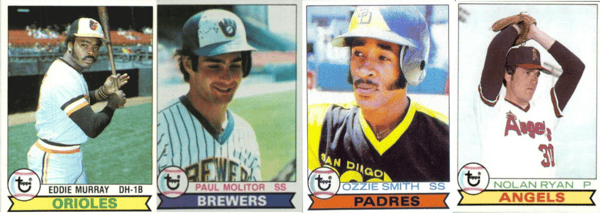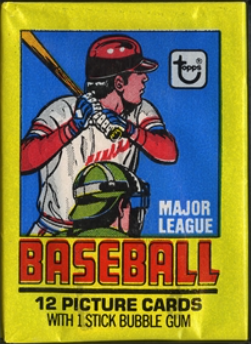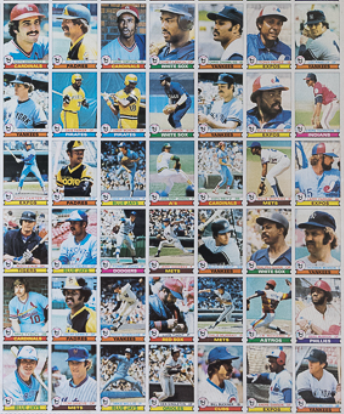1979 Topps Baseball Trivia
Topps decided to close off the decade with a solid design and an abundance of star-power in their 1979 baseball set. What really put this set on the map however, was the Ozzie Smith rookie card.
With that in mind, let’s pay tribute to one of the most collected sets of the 1970s by answering some of the frequently asked questions, as well as including some interesting and historic facts along the way.
1. As of today, which card in PSA 10 condition is the highest priced card in the 1979 Topps Baseball set?
The highest priced PSA 10, 1979 Topps Baseball card to date is card number 116 Ozzie Smith. There are only 5 PSA 10 Ozzie Smith rookies out of the almost 10,000 Ozzie rookie cards graded. The main reason for this is most of the rookie cards were cut off-centered during production.
Did you know that Ozzie Smith actually made his debut in 1978? However since Topps had not yet introduced the “Update” series, his first Topps card would have to wait until 1979.

2. How many cards are included in a 1979 Topps Baseball wax pack?
The 1979 Topps Baseball wax packs contained 12 cards. There were 36 wax packs in full Topps wax box. This wasn’t the only way these packs were distributed. They were also included in 1979 Topps grocery rack trays, which contained 3 wax packs on top of a cardboard backing and all were shrink wrapped. Interestingly, none of the wax boxes were shrink wrapped. Topps was famous for its frugal production process. The grocery tray was wrapped because it was sold in a retail environment and needed a price sticker. Since the wax box sale wasn’t considered a “retail” sale, there was no reason to wrap it in a cellophane shrink-wrap with a price on it. That would have been considered “wasteful.”

3. How many cards are included in a 1979 Topps Baseball rack pack?

There were 39 cards were included in each 1979 Topps Baseball rack pack. Each of the 3 rack pockets held 13 cards. Did you know the breakdown for all the ways Topps distributed baseball cards retail in 1979?
- Wax pack = 12 cards
- Cello pack = 18 cards
- Rack pack = 39 cards
- Super pack = 28 cards + 3 pieces of bubble yum (see image for dealer ordering information)

4. How much did a 1979 Topps Baseball rack pack cost?
As noted, there were 39 cards were included in each 1979 Topps Baseball rack pack. There was a header card at the end of the rack pack which contained pricing information, number of cards and production codes. The production code for the 1979 racks was 1-034-93-02-7.
The last number in the code references the production year, so why would a 1979 rack pack carry a 1977 production code? Simple, these headers were the same ones used since 1977 Topps football racks were released.
Topps produced baseball cards followed by football cards, which is logical as football follows baseball season. Thus, the last 10 cent price increase prior to 1980 occurred when Topps switched production from 1977 baseball (39 cards for 49 cents) to 1977 football (39 cards for 59 cents), and they simply used the same header card since that point until the price changed in 1980.
Take a look at the 1979 candy distributor ordering information below. These racks were sold in 6 box cases and for every 20 case order, Topps provided a free case. Thus, let’s do the math together to see what these cost and what profit margins may have looked like back in 1979.
- Cases cost $39 (who wouldn’t want to buy a truckload of those at that price now!). Thus, 20 cases cost $780 + 1 free case. So, 21 cases cost $780.
- There were 144 racks per case, thus 21 cases x 144 racks = 3,024 racks.
- At Topps full wholesale price, with the free case, they were charging 25.8cents per rack pack.
- The retail price was 59 cents. Thus, there was only 33.2cents total profit per pack to be split between the candy distributor and the retailer. Let’s assume the distributor marked it up 20%, thus your local candy store would have made about 30 cents in profit for each rack sold.

5. There was a famous error card with Bump Wills which had 2 different versions included in this set. Which two teams were shown on these two variations?
The famous 1979 Topps Bump Wills error cards showed Bump Wills incorrectly as a Blue Jay and correctly as a Texas Ranger. It was not unusual for Topps to have a production error here or there, but this was perhaps the most glaring of the 1970’s.
The story behind this was that Sy Berger at Topps had gotten “inside information” that Bump Wills was going to be traded from the Rangers to the Blue Jays. This was considered a “done deal.” Unfortunately, it wasn’t. Topps went into production with the “scoop” the Blue Jays were getting Bump Wills and cards were released in March 1979. By the time opening day rolled around, Topps fixed the card to show him properly as a Ranger. The Ranger variation is considered the scarcer of the 2.

6. As of today, what dollar range has the highest priced PSA 10 card reached?
The highest priced PSA 10, 1979 Topps Baseball card to date is card number 116 Ozzie Smith. In February 2021 at the Heritage Winter Auction, this PSA 10 rookie sold for a whopping $220,000! The owner of that card could have a profit upwards of $190,000 as the previous catalogued sale of that specific card was $36,000 back in 2017. Interestingly, there were no catalogued sales of this card from 2018 through 2020 as it is a very rare graded due to most of the Ozzie rookies being cut in an off-centered way during production

7. If you had a “full set,” how many cards would you have?
A full 1979 Topps Baseball set contains 726 cards. The design for 1979 cards was a pretty basic one. It showed the player with his name directly underneath. The name of the team went across the bottom of the card in a colored box, which was what kids used to “flip” cards in 1979. If you flipped a card with a red team color and your buddy then flipped a card with a red team color, he won the pile.
The key player in this set is the Ozzie Smith Rookie Card #116. There are also more than 25 future Hall of Famers included in this set including Nolan Ryan, George Brett, Robin Yount, Eddie Murray, Paul Molitor, Reggie Jackson and more.

Want to continue reading? Here are a few posts you might find interesting:
- 1970 Topps Baseball: Everything You Want To Know
- 1971 Topps Baseball: Everything You Wanted To Know
- A Look Back At The 1986-87 Fleer Basketball Set
- 1989 Ken Griffey Jr. Rookie: The Improbable Foresight of Upper Deck
- Ichiro Suzuki Rookie: What is the value of "Once in a Lifetime Cards?"
- Investing In Fleer Michael Jordan Cards? Here Is What You Need To Know

